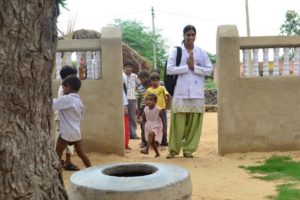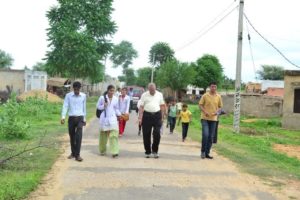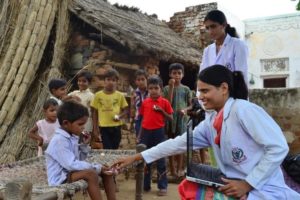Sustainable enterprise model built on empowering women
Arogya is an enterprise model for delivering low-cost healthcare to poor, remote Indian villages and urban slums whilst equipping young women to become health entrepreneurs.

The AI-driven platform, relies on standardizing and computerizing medical protocols for common, preventable illnesses and their symptoms such as respiratory or reproductive tract infections, pneumonia, minor injuries and diarrhea. These protocols are loaded onto a laptop which is hooked up to essential and portable diagnostic devices like a blood pressure monitor, oximeter, etc.
How it works
Young women are trained to assess patients using this ‘portable clinic’ and relay their findings to a physician, who reviews and provides a treatment plan. To ensure the program is viewed as a community asset aligned with the villager’s own values, the young women are called ‘pannas’ -after the 16th century nursemaid, Panna who is revered in Rajasthan, India.
Sustainable Innovations [SI] , a non-profit organisation [registered in Virginia, USA] trains girls from the community to become health workers-cum-entrepreneurs delivering healthcare to their communities through their own healthcare-delivery enterprises.B.P. Agarwal, President of SI said “as I wandered around the villages of Rajasthan, [India] I learned first-hand of the challenges of delivering healthcare to the vulnerable – the primary one is the inability to pay for basic care. ”

The health workers go door-to-door delivering basic care at a patient’s home for $1 or less. SI developed the proprietary mobile AI-driven platform. It provides the enterprises with seed capital, medical and computer knowledge, and managerial support.
The data captured by the pannas is stored in a data repository projected to grow to 200 million data elements in 3-5 years. Arogya will monetize the data and use the revenue to further subsidize the cost of care charged.

SI received approximately US$500,000 for development of Arogya from Merck Foundation, Jain Family Foundation, and World Bank to develop the platform.
Benefits
Arogya sets up an online communication loop with patient, health worker and physician for sharing of symptoms, treatment plans, follow up visits, interventions, and emergency care, thus shortening the time to access care. It maintains electronic “daily” diaries for patients with chronic conditions like blood pressure, sugar or low hemoglobin. The diary tracks effectiveness of prescribed care measures and alerts health workers and physicians, when necessary.
Some of the other benefits of this platform include:
- can save the patient out-of-pocket costs by maintaining a database of effective at-home remedies.
- built-in hooks for linking up with national medical databases for immunization records, free medicine, compliance reports, epidemics, health alerts, etc.
- allows assimilation with health and medical care through pharmacies, National Information Center, and other primary health facilities.
Plans
SI’s plan is to select 5 villages for the initial rollout of a primary health care services pilot, serving 10,000 people. Each individual in the village will be issued a Unique Health Identifier (UHI) card with their photo, QR code and UHI number. A health entrepreneur will go door-to-door capturing demographic and health data, typically 100-200 health data elements per individual.
On subsequent visits to patients, the health worker will capture symptoms and do triage at the patient’s home. The symptoms and triage results will be communicated via internet to a physician who will review the data, decide on a treatment plan, and generate a prescription through the platform.
Arogya will also alert the physician about the availability of “free medicines” provided by the government and home remedies that may be applicable for that particular ailment. The health worker will receive the prescription and relay it to the patient electronically or hand-deliver it. If intervention is required, the physician will alert the health worker to capture additional symptoms or to coordinate the patient’s visit to a physician, hospital or a laboratory.
Subsidizing Costs
Besides the small ticket-large volume service fee collection, Arogya creates electronic medical records with the clinical demographic data it captures. The program will sell the anonymized aggregate data to public and private institutions, including government, research institutes and pharma companies, to further subsidize the cost of its operations to the marginalized.
Arogya will also have the opportunity to earn supplemental income via its network of pannas through the partnering of government-initiated health awareness campaigns or by distributing health, hygiene and nutritional products sponsored by major corporations.
The organisation also plans to adapt this platform for the middle income market and use revenues from that to further subsidize the low income one.
Looking for partners
SI is seeking partners to leverage the already paid-for development of the Arogya platform and the services it offers. Together, the partners and SI can provide comprehensive primary health services to poor communities.
If you are interested please email cs@innovationhongkong.com and we will put you in touch.